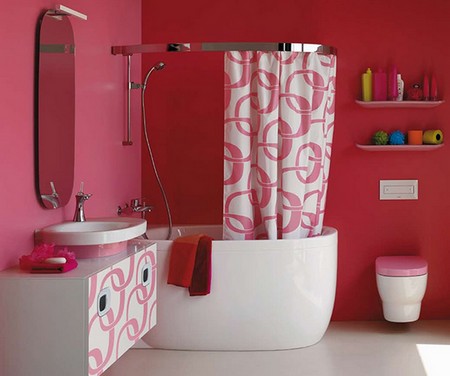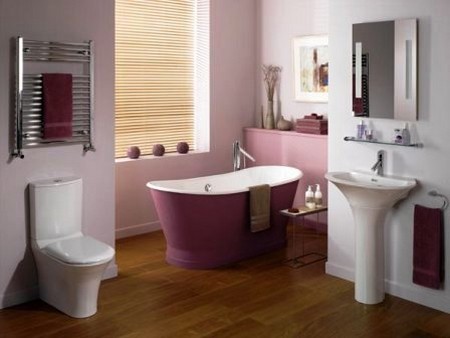Best Way to Create an Allergy-Free Bathroom
For many people, the bathroom is where they can luxuriate, stretched full-length in a steaming bath, or stand as the shower massages the tensions away As well as being somewhere private and relaxing, the bathroom should also be a healthy place for those with allergies. And, generally speaking, this is the case.
Most bathrooms are sparsely furnished and have easily dried, hard-surface floors, such as linoleum, vinyl, or tiles. Such a space is an inhospitable place for the dust mite, and is also somewhere that is easy to keep clean provided that you observe the general rule about minimizing clutter
Along with the kitchen, the bathroom is regarded as a “wet” room because of the amount of water vapour produced by such everyday activities as bathing or washing. During and after bathing or showering, keep the door firmly closed between the bathroom and the rest of the home. This will greatly reduce the amount of water vapour escaping; and if you leave a window in the bathroom open, or fit a powered extractor (exhaust) fan, most of the water vapour will escape outside.
The amount of moisture produced in a bathroom makes it an attractive proposition for cockroaches. Worldwide, cockroaches are second only to the house-dust mite as a cause of allergies, and one of the best ways of combatting them is to deprive them of moisture. In cockroach-prone regions, this means drying sinks, baths, and shower cubicles immediately after use.
Ornaments and decorations
- Keep ornaments and pictures to a minimum to prevent dust accumulating.
- Choose succulents or other types of plant that require little watering. A dry soil surface is not likely to encourage the growth of mould.
Medicine cabinet
- Take particular care to keep all medicines out of the reach of children in a secure medicine cabinet. Bear in mind that certain medications can provoke asthma attacks. This occurs most often with medicines containing aspirin, non-steroidal anti-inflammatory tablets, and beta-blockers used for heart disease (tablets) or for glaucoma (eye-drops).
- Be aware that some people are allergic to antibiotics, such as penicillin. In severe cases, this may lead to anaphylactic shock.
Bath
- Make sure that you thoroughly rinse away the residue of whatever you use to clean your bath and sink, especially if you have sensitive skin or eczema. Consider using a tolerated shampoo to clean the bath, especially if it is greasy from using bath oil or emollient: wipe on undiluted, scrub, and then rinse clean with the shower attachment.
- Add specially prepared bath oil to the water before bathing if you have eczema.
Toilet
- Always wear protective gloves when using the products sold for cleaning toilet bowls, and provide good ventilation. These are often powerful chemicals, some of which may irritate respiratory or skin conditions. Do not use sprays at all if they provoke respiratory symptoms.
Flooring
- Choose a hard surface flooring, such as sealed wood or cork, tiles, vinyl, or linoleum.
- Use washable cotton rugs in preference to wall-to-wall carpet or carpet tiles. Carpet will not dry easily if it becomes damp, and the moisture may encourage the rapid growth of the dust-mite population, as well as mould.
- Reduce condensation by opening a window during bathing (and leave it open afterward until all condensation has cleared), or install a powered extractor (exhaust) fan. Double- (secondary-) glazing also prevents condensation forming.
Walls
- Use washable and waterproof wallpaper or paint on walls and ceiling.
- Install tiling around the bath and as a splashback for the sink. Tiles are easy to clean and dry rapidly
- Avoid ornate mouldings, skirting (base) boards, dado rails, and other features that will become dust traps.
Shower and shower curtain
- Make sure that shower curtains dry quickly after use to inhibit the growth of mould. If mould does develop, remove it by rubbing in a paste made from one-third cup of vinegar or lemon juice and the same of borax, and then rinse well.
- Lay a new shower curtain outside in bright sunshine for a few hours to remove the odour that asthmatics may find an irritant. Alternatively, buy biodegradable cotton shower curtains, which have less odour.
- Consider buying “mould-free” shower curtains. These are impregnated with mould-retardant chemicals.
Towels
- Dry towels and bath mats in a tumble drier or outside, rather than over radiators, to prevent an increase in humidity inside.
Air fresheners
- Avoid using chemical air fresheners in the bathroom, which can irritate sensitive airways, or try the following gentle alternatives:
- One quarter cup of white vinegar or a bowl of cat litter set high up on a shelf will effectively deodorize the room.
- If you can tolerate sprayed products, dissolve 1 teaspoon of baking soda and 1 teaspoon of lemon juice completely in 2 cups of hot water. Place in a spray bottle and use as you would an air freshener
- A bowl of pot pourri is very effective, but the odour may provoke respiratory symptoms in some allergic people.
Categories
Advertisements
Recent Articles
 How to Understand Bed Sizes – A Small Guide
How to Understand Bed Sizes – A Small Guide How to Select Some Must Have Kitchen Accessories
How to Select Some Must Have Kitchen Accessories Best Way to Change a Car Tire
Best Way to Change a Car Tire Best Way to Write an Affirmation
Best Way to Write an Affirmation Best Way to Take Charge of Your Financial Life
Best Way to Take Charge of Your Financial Life Best Way to Survive a Party When You Don’t Know Anyone
Best Way to Survive a Party When You Don’t Know Anyone Best Way to Stop Self Sabotaging Yourself
Best Way to Stop Self Sabotaging Yourself Best Way to Start Journal Writing
Best Way to Start Journal Writing Best Way to Speak with a Powerful Voice
Best Way to Speak with a Powerful Voice Best Way to Simplify Your Life
Best Way to Simplify Your Life Best Way to Respond to a Put-Down
Best Way to Respond to a Put-Down Best Way to Reduce Acne Breakouts
Best Way to Reduce Acne Breakouts Best Way to Recover from Dining Disasters
Best Way to Recover from Dining Disasters Best Way to Quit Your Job Gracefully
Best Way to Quit Your Job Gracefully Best Way to Make Your Own Website
Best Way to Make Your Own Website




Leave a Reply